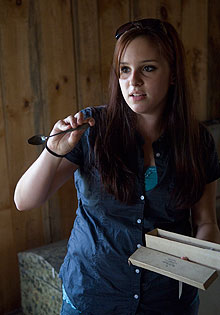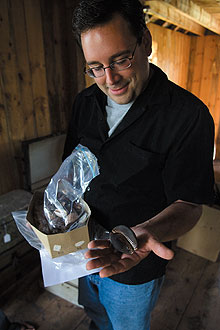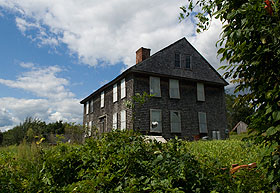  |
| HOME | THIS ISSUE | CALENDAR | GRANTS | BACK ISSUES | < BACK | NEXT > |
Avery Point students documenting artifacts from historical homesteadby Cindy Weiss - October 14, 2008
| ||||||
Five students from the Avery Point campus are learning history direct from a primary source – a 1670 colonial house in Stonington that has been in the same family for more than 300 years.
The Stanton-Davis Homestead housed 12 generations of family members, who left behind diaries, furniture, clothing, quilts, and traces of their relationships with Native Americans and slaves. Artifacts and furniture cram its rooms. The last inhabitant, John Whit Davis, left the center-chimney colonial two years ago to a non-profit group that plans to turn it into a museum. But the Stanton-Davis Homestead Museum Inc. faces the daunting task of documenting and removing roomfuls of historic objects before it can renovate the deteriorating house. Nancy Steenburg, adjunct history faculty member and assistant director of the Bachelor of General Studies (BGS) program at Avery Point, learned of the project’s needs from fellow Stonington Historical Association board member Fred Burdick, who is vice president and treasurer of the Stanton Davis Homestead Museum. Steenburg arranged for students at Avery Point to hold internships at the museum. Five students, representing a range of majors in the College of Liberal Arts and Sciences – history, maritime studies, English, and American studies – and a BGS student have spent months learning firsthand about the past four centuries. They are opening trunks, inventorying objects, and learning how to research and carefully document their finds, using Past Perfect, a software system used by museum curators. They work with photographs, letters, clothing, furniture, and the tools of everyday life. “This is the guts of history,” says Steenburg. Dana Canastar, an American studies major, learned from papers he found in a trunk that in 1764 the Stantons lost the house, which was collateral on a mortgage, before it was sold to their relatives, the Davises. Previously, it had been thought that the Stantons leased it to the Davises, who later bought it. Canastar searched land records in Stonington and Hartford to confirm his find. Jane Schoonover, the BGS student, found two handwritten books of poetry by Sarah Mariah Davis in an old leather suitcase. Sarah started writing poetry and commentary when she was 14, in 1870, and continued until 1934, never publishing the pieces. Some of it is heartbreaking, Schoonover says. Davis felt that she could have done so much more with her life if she had been educated and if she had not been the daughter and wife of farmers. Jodi Parda, a senior majoring in maritime studies, plans to go to graduate school in museum studies as a result of working at the homestead, where she has spent hours documenting finds such as a dessert or baby spoon with the initials AD, possibly belonging to Abigail Davis. Jay Murzyn, a senior majoring in English and history, found a collection of shells he thinks were gathered locally but are of a type no longer found in Stonington.
The task of sorting and researching the objects so captivated the interns that they volunteered to come back and continue the work after their internships ended. For more information on the Stanton Davis Homestead, go to http://www.stantondavishomestead.org/
The Stanton-Davis Homestead is steeped in history.John Whit Davis, its last inhabitant and president of the museum, no longer lives in the house, but still harvests the salt marsh hay as his ancestors did, starting in 1654. He sold the future development rights to the 258-acres of farmland to the state. The farm’s bounty once fed Washington’s troops in the Continental Army and provisioned whaling ships. The objects in the house span several centuries and styles. A soldier’s blue and red coat from the Revolutionary War was found in a paper bag. According to folklore, a drop-leaf table in the parlor was used by Uncas, the Mohegan sachem, when he wrote his will. Open the drawer of an 1845 cherry and curly maple butler’s chest and you can find a pill container filled with pebbly objects, labeled, “John L. Davis’s 40 gallstones.” Open a trunk and there is a diary logging the daily work of the Davises beginning in the 1500s, when they farmed in England, and including their migration to Long Island, where they first settled on this side of the Atlantic, and their later move to the Stonington property. Just outside the house is the 442-pound “Venture stone,” named for the slave-turned-freeman Venture Smith, who is said to have lifted it. Venture once lived in the Thomas Stanton Jr. house, three-quarters of a mile away.
Nearby in the Davis cemetery lie the remains of Cuff Stanton, a contemporary of Venture’s who was born in Africa and enslaved. He took the place of his owner, Zebulon Stanton, as a soldier in the Revolutionary War, says Steenburg. That earned him freedom, and he became a preacher. His epitaph reads, “Thought to be a Christian.” The attic of the Stanton-Davis House bears marks of the slaves who lived there. Primitive drawings of slave ships and figures are etched and carved into the low beams of the attic eaves, where the slaves slept. |
| ADVANCE HOME UCONN HOME |



